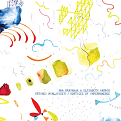Some thoughts on three new CD of free improv:
-Ana Kravanja & Elisabeth Harnik: Vrtinci Minljivosti (Vortices of Impermanence), Creative Sources
-Cory Smythe: Smoke Gets in Your Eyes, Pyroclastic Records
-VocColours: 66, Tonkunkst Manufaktur
___________________________________________________________
 Since last year, Slovenian violinist/violist/vocalist Ana Kravanja and pianist Elisabeth Harnik, based in Graz, Austria, have been playing together as a duo. Vrtinci Minljivosti (Vortices of Impermanence), recorded in October 2022 in Slovenia, is their debut album; although it documents their collaboration at a relatively early stage, it gives evidence of a chemistry that already feels well-developed.
Since last year, Slovenian violinist/violist/vocalist Ana Kravanja and pianist Elisabeth Harnik, based in Graz, Austria, have been playing together as a duo. Vrtinci Minljivosti (Vortices of Impermanence), recorded in October 2022 in Slovenia, is their debut album; although it documents their collaboration at a relatively early stage, it gives evidence of a chemistry that already feels well-developed.
Kravanja is an experimental artist with a broad range of interests; in addition to her work with Harnik both in duet and as a trio with the addition of Margarethe Maierhofer-Lischka, plays in the folk-rooted, acoustic-improvised trio Širom. On Vortices of Impermanence her folk and traditional influences move to the background in favor of a highly contemporary sound crafted from extended string techniques and a late modern sensibility of tightly coiled emotional dynamics. Harnik, for her part, complements and amplifies this side of Kravanja’s playing by contributing a pianism informed by the more experimental currents of contemporary composition and free improvisation.
The album contains nine tracks jointly credited to both Kravanja and Harnik. The first track, Zavito v skrivnost (Veiled in Mystery) introduces the set with the skitterings of percussion and prepared piano played directly on the strings, eventually joined by pressure-bowed and pizzicato violin. This piece, with its blend of pitched and unpitched sounds, captures in microcosm much of what follows. Prebivalci z druge strani (Dwellers of the Other Side) opens with sparsely played piano notes and chords allowed to linger and fade before seguing into more assertive, repeated motifs layered over tapped and rattled metal percussion. The tentatively paced Sledi pušcavnika (Hermit Footsteps) features Kravanja’s violin heard from a variety of angles: through tremolo bowing, harmonics, and brittle overtones. The album culminates in Semena resnice (Seeds of Truth), a suspenseful, minimal soundscape of fragmentary piano and harshly elemental violin.
 How is it that a decades-old popular song can continue to inspire interpreters to find in it new possibilities not only of expression, but of formal exploration? It’s a question that probably can be asked of many of the tunes that make up the Great American Songbook, some of which may have begun life as near-throwaways for Broadway shows but instead became lasting monuments to the songwriter’s craft. Smoke Gets in Your Eyes, the Jerome Kern/Otto Harbach standard, is one of those songs. Originally composed in 1933 for the show Roberta, it has held up through its various interpretations and reworkings over the past ninety years. One of the song’s more intriguing and radical interpreters is composer/pianist Cory Smythe, who describes his album Smoke Gets in Your Eyes as a set of “more or less oblique” perspectives on the tune.
How is it that a decades-old popular song can continue to inspire interpreters to find in it new possibilities not only of expression, but of formal exploration? It’s a question that probably can be asked of many of the tunes that make up the Great American Songbook, some of which may have begun life as near-throwaways for Broadway shows but instead became lasting monuments to the songwriter’s craft. Smoke Gets in Your Eyes, the Jerome Kern/Otto Harbach standard, is one of those songs. Originally composed in 1933 for the show Roberta, it has held up through its various interpretations and reworkings over the past ninety years. One of the song’s more intriguing and radical interpreters is composer/pianist Cory Smythe, who describes his album Smoke Gets in Your Eyes as a set of “more or less oblique” perspectives on the tune.
Smoke Gets in Your Eyes divides into two distinctive parts. The first part comprises two versions each of the Smythe compositions Liquiform and Combustion, which are realized by a big band consisting of vocalist Sofia Jernberg, and a string section of Joshua Modney on violin and Tomeka Reid on cello; a brass section of Peter Evans, trumpet and Zekkereya El-magharbel, trombone; a reed section of Ryan Muncy, alto saxophone, Ingrid Laubrock, tenor saxophone, and David Leon, alto and baritone saxophones and clarinet; and a rhythm section of Jessie Cox on drums and percussion, Stephan Crump on acoustic bass, and Smythe himself on piano. In Combustion No. 2, the album’s opener, the Kern/Harbach tune at the core of Smythe’s composition is most transparently present, even as it undergoes considerable distortions of tempo and harmony. The song’s underlying form, and the vocals-and-string-of-solos structure typical of a jazz interpretation, don’t quite completely dissolve, although they do seem at times to be on the verge of doing so. The other Combustion and the two Liquiforms, on the other hand, move far away from anything resembling the song and instead enter the highly abstract realm of fractured sound and discontinuous form. The album’s second part consists of seven solo performances for Smythe on piano, supplemented by electronics. Here again the treatment is highly abstract—the “more” of Smythe’s “more or less oblique”–and exploratory. Smythe’s playing ranges from minimal, to free, to inside-the-piano unconventionality. In addition, the electronics add a subtle warp and wobble to the instrument’s sound rendering these seven performances surely among the most radical variations ever derived from Kern and Harbach’s ballad.
 VocColours, a compression of “vocal” and “color,” are the quartet of Brigitte Küpper, Gala Hummel, Iouri Grankin and Norbert Zajac. The four are vocalists who utilize a variety of extended techniques to take vocal timbres– “colors” — into often uncanny areas. 66 is the group’s sixth album, on which they are joined by a number of instrumentalists who play in various combinations over the course of eleven highly eclectic tracks.
VocColours, a compression of “vocal” and “color,” are the quartet of Brigitte Küpper, Gala Hummel, Iouri Grankin and Norbert Zajac. The four are vocalists who utilize a variety of extended techniques to take vocal timbres– “colors” — into often uncanny areas. 66 is the group’s sixth album, on which they are joined by a number of instrumentalists who play in various combinations over the course of eleven highly eclectic tracks.
The very first sounds of the album are the group alone: two male and two female voices in a growing Babel of wordless chanting, stuttering nonsense syllables, shouting, laughter, gurgling, throaty singing, and sounds that defy description. Trumpet, guitar, bass, and drums add to the pandemonium. This first track sets the general template for much of what follows, with variety provided by changes in the weave of textures as voices enter and exit and instruments come and go. Klezmeresque, for example, features Iouri Grankin as the sole vocalist placed against a backing of clarinet, accordion, and drums; the quartet’s free interplay is a very distant relative of the genre that inspires them. Firebird reverses the proportion of instruments to voice—all four vocalists are represented alongside a sole cornet. Ein weisses Pferd, a performance of textural metamorphoses in which all voices and instruments are involved, fittingly brings the album to a close.
No matter how extraordinary these performances’ sounds, the essential nature of the human voice–the breath-based and most basic of all musical instruments–remains at the center of them all.







